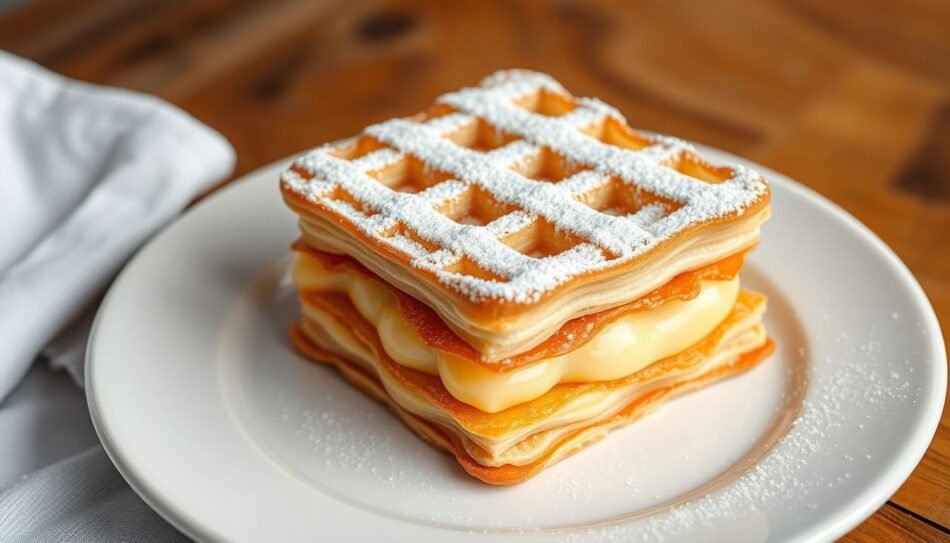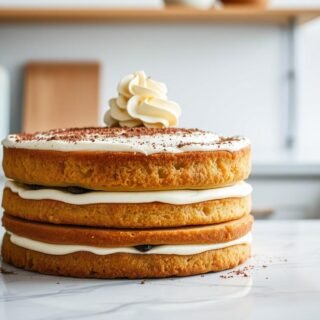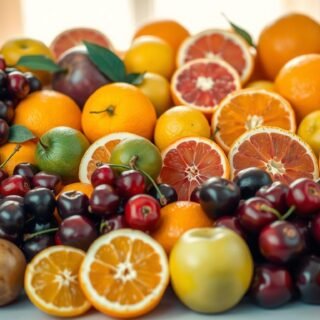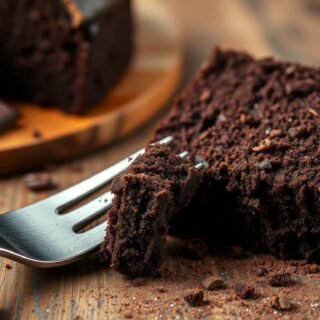Discover how to create delectable mille feuille and cake at home. Learn expert techniques, essential ingredients, and pro tips for crafting these classic French pastries to perfection.
Every time I smell the sweet aroma of French pastry, I’m taken back to Paris. It was there I first tasted a perfect mille feuille. The layers of golden puff pastry, the creamy filling, and the glaze all combined in a magical moment.
French desserts like mille feuille and cake are more than just treats. They celebrate the art of cooking, blending skill and taste into unforgettable moments. Whether you love baking or just enjoy trying new foods, making these desserts at home is a thrilling adventure.
You’ll learn the secrets of making the most delicious mille feuille and cake. You’ll discover techniques passed down through generations. Get ready to bring French pastry magic into your kitchen.
Key Takeaways
- Mille feuille translates to « thousand leaves » in French
- Traditional French pastry requires precision and patience
- Homemade desserts offer a deeper culinary connection
- Layered pastries combine texture and flavor beautifully
- French baking techniques are learnable for home cooks
Understanding the Art of French Pastry Making
French pastry making is a delicate craft that turns simple ingredients into amazing treats. It’s a world of layered puff pastry and napoleon cake. Here, passionate bakers dive into the rich traditions of Parisian bakery delights.
Origins and Cultural Significance
In the 17th century, French pastry showed off sophistication and new culinary ideas. The mille-feuille, with its thin layers, became a sign of fine dining. Parisian bakery treats were more than desserts. They showed artistic skill and cultural value.
« Pastry is the poetry of food, where technique meets imagination. » – French Pastry Chef
Traditional vs Modern Interpretations
French pastry has evolved, showing great adaptability. Old techniques still inspire today’s bakers. They update classic recipes, like the napoleon cake.
- Classic layered puff pastry techniques
- Innovative flavor combinations
- Fusion of historical and modern approaches
Essential Baking Equipment
For top-notch pastries, you need the right tools. Professional bakers use the best equipment to get perfect results.
| Equipment | Purpose | Recommended Quality |
|---|---|---|
| Rolling Pin | Creating uniform pastry layers | Professional-grade wooden |
| Pastry Brush | Applying egg wash | Natural bristle |
| Baking Sheet | Even heat distribution | Heavy-duty aluminum |
Starting your journey in French pastry making means learning these basics. Each technique and tool helps you get closer to making beautiful Parisian bakery treats.
Mille Feuille and Cake: A Perfect Culinary Marriage
Imagine a dessert that mixes the crunch of flaky pastry with the smoothness of custard cream. Mille feuille is the top of elegant European sweets, blending cake and pastry skills.
This dessert’s magic is in its layers. Each bite is a mix of textures and tastes:
- Crisp, buttery puff pastry layers
- Luxurious vanilla pastry cream
- Delicate architectural structure
Making these stunning desserts needs precision. Your skill is as important as your ingredients. A traditional mille feuille has three puff pastry layers and two vanilla custard cream layers. It’s a mix of taste and texture.
Baking is an art where science meets creativity, and mille feuille embodies this philosophy perfectly.
Mastering flaky pastry and creamy fillings opens a world of possibilities. These elegant sweets are perfect for any event, from casual to fancy.
The key is knowing how textures and flavors work together. Your custard cream pastries shine, turning simple ingredients into a special dessert.
Mastering Puff Pastry Techniques
Making perfect layered puff pastry needs skill and precision. It’s important for both home bakers and pastry chefs. To get it right, you must pay attention to detail and practice a lot.
Store-bought vs Homemade Options
When making layered puff pastry, you can choose between store-bought or homemade. Each has its own benefits:
- Store-bought pastry is easy and gives consistent results
- Homemade pastry lets you control ingredients and texture
- Experts suggest trying both methods to improve
Rolling and Folding Methods
To get those flaky layers, you need to roll and fold carefully. Your goal is to make thin, even layers that puff up well when baked.
| Technique | Key Considerations |
|---|---|
| Classic Folding | Create multiple butter and dough layers by carefully folding and rolling |
| Lamination Process | Develop consistent butter distribution for maximum flakiness |
Temperature Control Tips
For flaky pastry, controlling temperature is key. Keep your ingredients cold and work fast to avoid melted butter.
- Chill dough between folding sessions
- Use a marble surface for rolling when possible
- Rest pastry in refrigerator to maintain structural integrity
Learning these basic techniques will make your layered puff pastry truly special.
Creating the Perfect Vanilla Pastry Cream
Mastering custard cream pastries starts with making silky smooth vanilla pastry cream. This key ingredient makes your desserts stand out. It turns simple pastries into professional-quality treats.
Start with high-quality ingredients for your vanilla slice variations. The perfect pastry cream needs precision and technique. You’ll need:
- Fresh whole milk
- Vanilla beans or pure vanilla extract
- Granulated sugar
- Egg yolks
- Cornstarch
- Unsalted butter
The secret to great custard cream pastries is careful preparation. Start by whisking egg yolks with sugar until they’re pale and creamy. Then, add cornstarch to avoid lumps. Heat the milk with vanilla, then slowly mix in the egg mixture for a smooth, rich base.
When cooking your pastry cream, keep the temperature right. Stir constantly over medium heat until it thickens and coats the back of a spoon. Remove from heat and add butter for extra richness. Let the cream cool completely before using it in your vanilla slice variations.
Pro tip: Strain your pastry cream through a fine-mesh sieve to ensure a perfectly smooth texture.
How you store your pastry cream is just as important as how you make it. Cover the surface with plastic wrap to prevent a skin from forming. Refrigerate for up to three days. Your homemade vanilla pastry cream will be the secret to stunning desserts that impress every time.
Essential Ingredients for Professional Results
Creating amazing french pastry desserts starts with the right ingredients. Your success in traditional French desserts depends on choosing high-quality components. These ingredients should work well together.
Professional bakers know that ingredient quality is key. The right ingredients can turn simple baking into a special culinary experience.
Selecting Quality Butter
Butter is the heart of French pastry desserts. Look for these key characteristics:
- High butterfat content (around 82-85%)
- Unsalted varieties for precise flavor control
- European-style cultured butter for enhanced richness
Flour Types and Their Effects
Different flour types change your traditional French desserts’ texture and structure:
- Pastry flour: Produces tender, delicate layers
- All-purpose flour: Versatile but less precise
- Cake flour: Creates extremely soft, light pastries
Flavoring Components
Elevate your french pastry desserts with strategic flavoring choices:
- Pure vanilla extract from Madagascar
- High-quality chocolate with minimum 70% cocoa content
- Fresh, seasonal fruits for natural sweetness
Professional bakers understand that ingredient quality reflects passion and skill.
By carefully selecting each ingredient, you’ll craft traditional French desserts that are truly remarkable.
Layer Assembly and Decoration Techniques
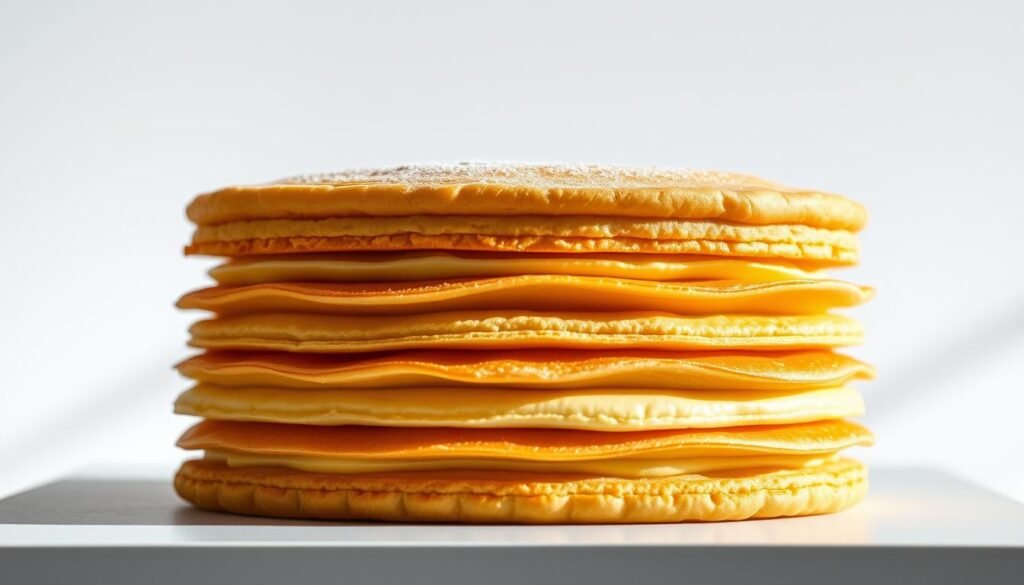
Making elegant European treats like the napoleon cake needs precision and creativity. Your layering can turn a simple pastry into a beautiful dessert. It will impress both the eyes and taste buds.
Begin by setting up a clean, flat area for your napoleon cake. The secret to great layers is keeping everything even and consistent. This applies to both the pastry and the cream.
- Use a sharp serrated knife to cut puff pastry sheets precisely
- Apply pastry cream in smooth, uniform layers
- Maintain equal thickness for each pastry sheet
- Chill layers between applications to ensure stability
When decorating your napoleon cake, bakers suggest a few key methods to make it look amazing:
- Classic white icing glaze
- Chocolate feathering
- Caramel drizzle patterns
- Powdered sugar dusting
| Decoration Technique | Difficulty Level | Visual Impact |
|---|---|---|
| White Icing Glaze | Easy | Classic, Clean |
| Chocolate Feathering | Intermediate | Sophisticated |
| Caramel Drizzle | Advanced | Artistic, Gourmet |
Getting better at making these elegant treats takes practice. With each try, your napoleon cake will get better. You’ll improve your skills and add your own creative touch.
Creative Flavor Variations and Combinations
Exploring vanilla slice variations opens a world of creativity for bakers. Parisian bakery treats inspire new ways to make the classic mille-feuille special. Your dessert can become a canvas for exciting flavor combinations that wow the senses.
Seasonal Fruit Inspirations
- Summer berries: Add fresh raspberries or strawberries between pastry layers
- Autumn harvest: Try poached pears or caramelized apple compote
- Citrus twist: Mix in blood orange or passion fruit for a tangy taste
Decadent Chocolate and Nut Enhancements
- Dark chocolate ganache for a rich flavor
- Roasted hazelnut praline for a crunchy surprise
- Pistachio cream with white chocolate drizzle
Special Occasion Adaptations
Turn your vanilla slice into a stunning dessert for special events. Here are some elegant ideas:
- Wedding celebration: Use champagne-infused cream
- Birthday surprise: Layer salted caramel and chocolate
- Holiday gathering: Add a spiced winter flavor
By trying these creative ideas, you’ll make parisian bakery treats that look great and taste amazing. The secret is mixing traditional methods with new flavors.
Storage Tips and Serving Suggestions
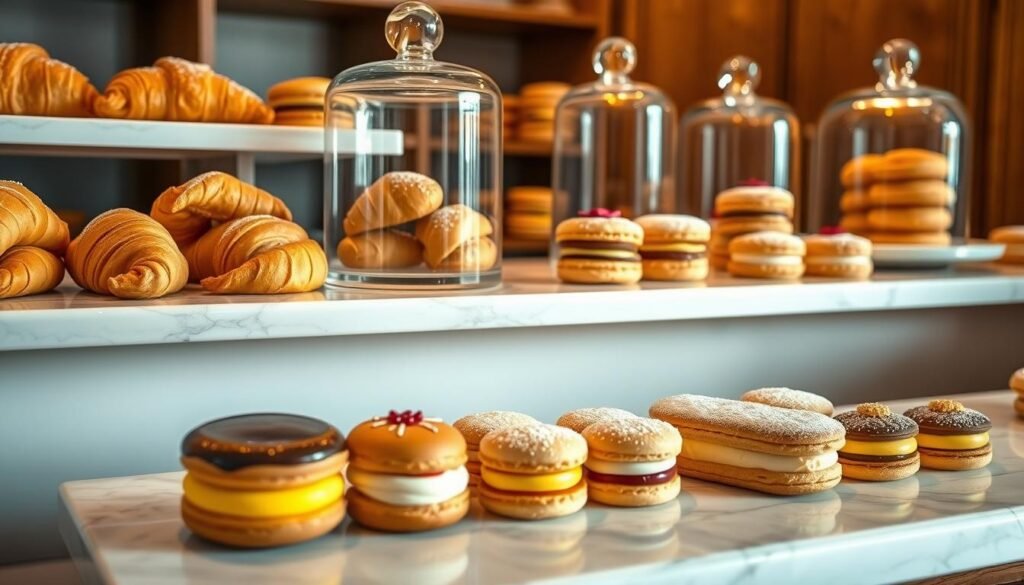
Keeping the texture and taste of French desserts fresh is key. When making mille-feuille or other French pastries, timing is everything. This ensures the layers stay crisp and the filling creamy.
Here are some important storage tips:
- Assemble your french pastry desserts no more than 12-24 hours before serving
- Store in a cool, dry refrigerator to prevent soggy pastry layers
- Use an airtight container to protect against moisture
- Keep pastries away from strong-smelling foods that might compromise their delicate flavor
Serving these desserts needs a bit of flair. Here are some presentation ideas:
- Dust with powdered sugar just before serving for a classic look
- Use chilled plates to maintain pastry crispness
- Garnish with fresh berries or mint leaves for added visual appeal
- Serve immediately after plating to preserve texture
« The secret to an exceptional french pastry dessert lies not just in its preparation, but in its precise presentation and timing. » – French Pastry Chef
Pro tip: If you’re not serving immediately, store the pastry components separately and assemble just before serving to keep the layers crisp and appetizing.
Troubleshooting Common Pastry Problems
Making perfect layered puff pastry can be tough for home bakers. Knowing common issues with flaky pastry recipes helps you fix problems and get great results.
When working with layered puff pastry, several problems can happen. Spotting these issues early lets you make quick fixes. This keeps your pastry’s texture and look just right.
- Uneven rising in your puff pastry layers
- Soggy or collapsed pastry structure
- Filling leakage during baking
- Inconsistent browning
Temperature control is key for flaky pastry recipes. Keep your ingredients and workspace cool. This stops butter from melting too soon. Chilled dough ensures distinct, crispy layers.
| Problem | Potential Cause | Solution |
|---|---|---|
| Butter seeping out | Warm kitchen temperature | Refrigerate dough between folding stages |
| Flat layers | Insufficient resting time | Allow 30-minute cooling between folding |
| Uneven browning | Inconsistent oven temperature | Use oven thermometer, rotate pastry midway |
Cutting layered puff pastry needs care. Use a sharp serrated knife and gentle sawing. This keeps the delicate layers intact without damage.
Professional bakers know that patience and technique are key to perfect pastry.
Conclusion
Mastering mille feuille and cake takes practice, passion, and patience. Your journey into these elegant European confections opens a world of delicious possibilities. Each layer you create is a step toward becoming a skilled pastry chef.
The techniques you’ve learned are more than recipes—they’re gateways to creative expression. Whether you’re rolling delicate puff pastry or whisking smooth pastry cream, you’re developing skills that connect you to generations of baking traditions. Your homemade mille feuille and cake will become cherished memories shared with family and friends.
Start experimenting with your newfound knowledge. Mix unexpected flavors, explore seasonal ingredients, and trust your culinary intuition. Every pastry chef began exactly where you are now—curious and eager to learn. Your kitchen is your canvas, and these elegant European confections are your art.
Remember that baking is both a science and an adventure. Embrace imperfections, learn from each attempt, and celebrate your progress. Your mille feuille and cake will improve with every batch, turning you into a confident home pastry maker who can create restaurant-quality desserts.

